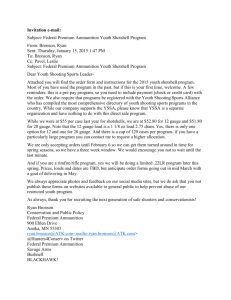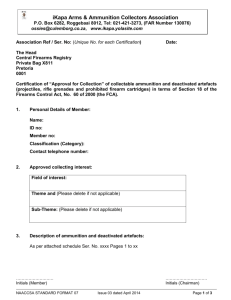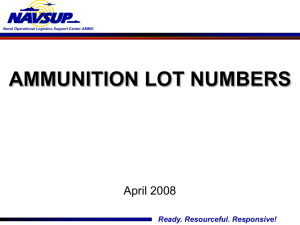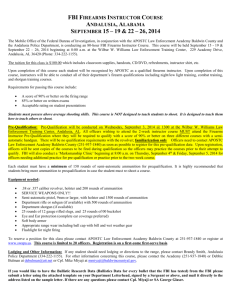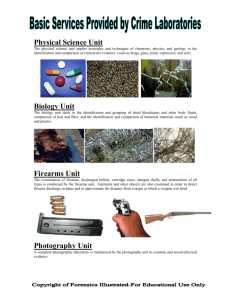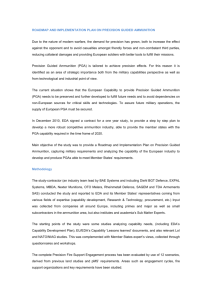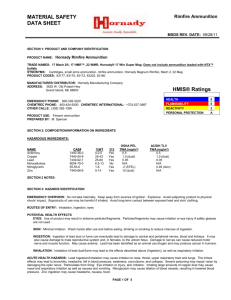Camp Ripely ASP - Minnesota National Guard
advertisement
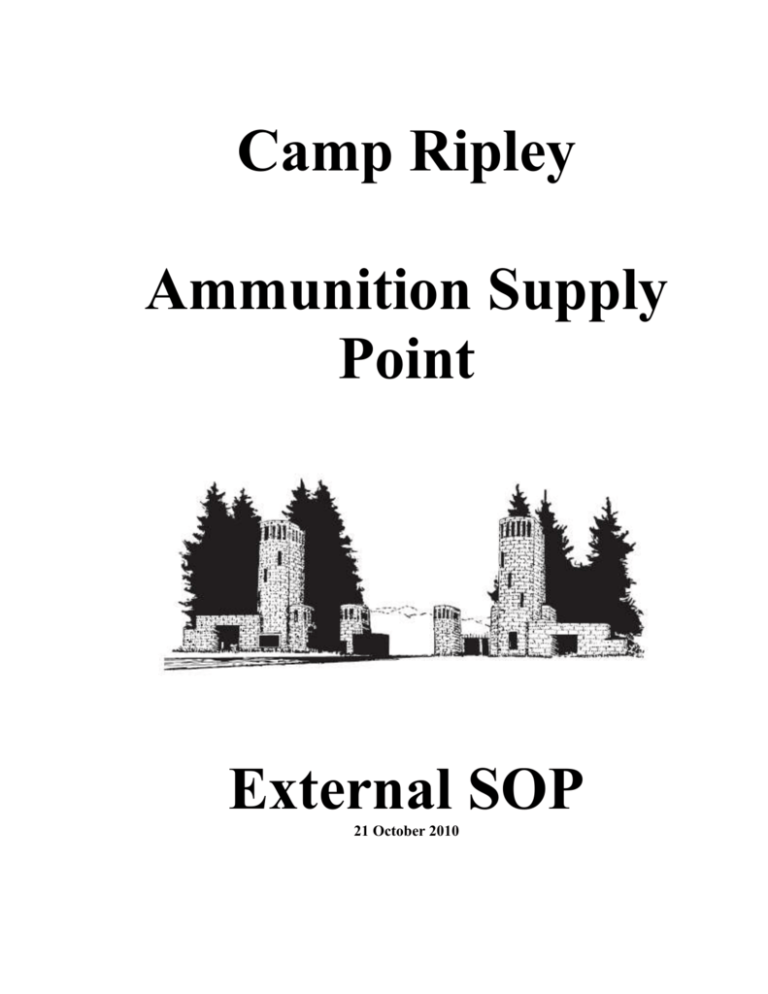
Camp Ripley Ammunition Supply Point External SOP 21 October 2010 Camp Ripley ASP External Standing Operating Procedures CONTENTS PAGE Table of Contents……………………………………………………...... I SECTION I INDRODUCTION……………………………………………………… 1 Purpose and Scope……………………………………………………… 1 General………………………………………………………………….. 1 Responsibilities……………………………………………………......... 1-2 Concept of Operations………………………………………………….. 2 Safety and Security……………………………………………………... 2-3 Reference & Forms……………………………………………………… 3-4 SETION II DETAILED AMMUNITION PROCEDURES FOR UNITS 4 Step 1 Forecasting……………………………………………………….. 4 Step 2 DA Form 1687…………………………………………………… 5 Step 3 Assumption of Command………………………………………... 5 Step 4 DA Form 581…………………………………………………….. 5 Step 5 Receiving Training Ammunition…………………………………. 5 Step 5a Ammunition Shipping, Movement and Receipt…………………. 5 Step 5b Transportation of Small Arms Ammunition……………………… 5 Step 6 DA Form 5515…………………………………………………….. 6 Step 7 Preparing to Turn-In Ammunition & Residue…………………….. 6 Step 8 Dual Driver Protective Service (DDPS)…………………………… 6 Step 9 DA Form 5692-R…………………………………………………… 6 Step 10 DA Form 5811-R………………………………………………….. 6 Step 11 Checklist…………………………………………………………. 6-7 SECTION III AMMUNITION AMNESTY PROGRAM………………………… 8 1 SECTION I INTRODUCTION 1. Purpose and Scope: This SOP establishes ammunition supply procedures for Camp Ripley identifies support to customers and their responsibilities. It adheres to Department of Defense (DOD), Department of the Army (DA), and Forces Command (FORSCOM) security, accountability, safety and logistics regulations. 2. General: Munitions are one of the most expensive commodities used by the Armed Forces. Because of the huge volume required for training, special procedures were implemented by the Department of the Army to insure that all organizations receive only authorized training ammunition. Army Regulation 5-13 and the Training Ammunition Management information System (TAMIS-R) established guide lines to insure that organizations received authorized requirements and to stop the misuse, abuse, and stock piling of training ammunition. It is imperative that all individuals involved with training ammunition be fully aware of these directives and their impact if not adhered to. This installation WILL NOT issue ammunition to any unit without the requirements in this SOP being met. All correspondence will be sent to the address below: Logistics Officer Attn: JFMN-CRC-LOG 1500 HWY 115 Camp Ripley, MN 56345 3. Responsibilities: The Logistics Officer has the overall responsibility for the operation of the Installation Ammunition Supply Point and related activities. It is the responsibility of the Ammunition Supply Point to insure that all units comply with the requirements set forth in this SOP. All personnel involved in ammunition activities will comply with DOD/DA/FORSCOM and applicable SOP’s governing ammunition operation. It is the user’s responsibility to be aware of and in compliance. a. AMMUNITION SUPPLY POINT (ASP) responsibilities: (1) Prepare, revise, & publish external Class V SOP IAW current regulations, directives & policies. (2) Furnish ammunition based on quantities authorized. (3) Manage all training ammunition using Standard Army Ammunition System (SAAS) (4) Strictly observe ammunition requisition procedures. (5) Maintain stock levels for mission requirements. (6) Consolidate monthly training ammunition forecasts from the appropriate commands. (7) Process all requests for issue/turn in. (8) Receive, store, issue and retrograde ammunition. (9) Observe & enforce explosive safety, security and accountability requirements during all operation. (10) Shipment of ammunition and residue as directed. b. Major Subordinate Commands (MSC) or Organizations having final approving authority of DA Form 581 (1) Review & approve of all requests of ammunition (DA581) submitted by subordinate units. (2) Manage & maintain records of subordinate units’ authorizations & expenditures. (3) Ensure that DA Form 581s are IAW DA Pam 710-2-2. 1 I (4) Review subordinate units’ forecasts through TAMIS and verify approved forecast. (5) Major Subordinate Commands (MSC) or organizations having final approving authority of DA Form 581 will forward DA Form 1687 & assumption of command. (6) Approve issues for home station/other posts. c. Unit responsibilities: (1) Analyze scheduled training and unit strength to eliminate unnecessary/unauthorized expenditures and ensure that class V requests are limited to items and quantities actually authorized. (2) Monthly submission of accurate ammunition forecasts to Major Subordinate Command (MSC) for approval. (3) Reconcile DA Form 581s in TAMIS. (4) Maintain safe practices and appropriate security when handling, transporting, storing, and using ammunition. (5) Maintain appropriate regulations and SOPs for types of ammunition and operations being performed. (6) Maintain accountability for all ammunition and residue components under unit control. (7) Ensure that personnel managing, handling and transporting ammunition have been screened, trained, and certified IAW AR 190-11, AR 600-55, 49 CFR & DOD 4500.9-R (8) Ensure that DA1687 & DA581’s with original signatures are forwarded to the ASP. Assumption of Command orders must accompany DA 1687. 4. Concept of Operation: The Post ASP will store and issue all authorized Class V (ammunition) items required to satisfy the needs of units training at Camp Ripley. Some items may not be available, but every effort will be made to issue, a suitable and authorized substitute item. All issues will be made from the ASP. Separate DA Form 581s will be submitted for each scheduled issue. 5. Safety and Security: The paramount consideration in operating an ASP is the safety and security of personnel, equipment and stocks. When conflicts occur between safety, security and training realism; safety and security will be given priority, Class V items are deliberately designed to be dangerous and destructive. All personnel associated with the Post ASP must be constantly aware of the potential dangerous and destructive qualities of these items. Maintaining safety and security of each respective storage point must receive special command emphasis from all personnel involved in carrying out their assigned mission. a. General Safety Requirements: (1) All personnel engaged in ASP or munitions Operations will be thoroughly trained in explosive safety, FORSCOM Rep 700-4, DA PAM 385-64, and be capable of recognizing explosive hazards. (2) Improper, rough, and/or careless handling of explosive materials will not be allowed. (3) Munitions will be handled under the direct supervision of competent personnel who thoroughly understand the hazards and risks involved. (4) The minimum number of personnel will be exposed for the minimum time to the smallest quantity of explosives, consistent with safety, efficiency 2 I and unit mission. Unnecessary personnel will be barred from hazardous areas b. General Security Requirements: (1) Munitions Storage Areas will be established IAW AR 190-11, DOD Manual 5100, 76M DA PAM 385-64. (2) All personnel involved with munitions are responsible for security to prevent unlawful entry, theft or intentional destruction. 6. References and Forms: ASP Forms and References a. Forms using units will need to have prepared (if applicable): DA Form 581 Request for Issue and Turn-In of Ammunition DA Form 2203-R Demolition Reconnaissance Report DA Form 5514-R TAMIS Training Ammunition Forecast Report DA Form 5515 Training Ammunition Control Document DA Form 5692-R Ammunition Consumption Certificate DA Form 5811-R Certificate - Lost or Damaged Class 5 Ammunition Items DA Form 626 Motor Vehicle Inspection (Transporting Hazardous Materials) DA Form 836 Emergency Response Information b. References used to compile information: AR 5-13 Training Ammunition Management System AR 75-1 Malfunctions Involving Ammunition and Explosives AR 75-15 Explosive Ordnance Disposal AR 190-11 Physical Security of Arms, Ammunition and Explosives AR 190-13 The Army Physical Security Program AR 385-63 Policies and Procedures for Firing Ammunition for Training, Target Practice and Combat AR 385-10 The Army Safety Program AR 702-5 Missile Firing Data Reports AR 702-6 Ammunition Stockpile Reliability Program (ASRP) and Army Nuclear Weapons Stockpile Reliability Program (ANWSRP) AR 710-2 Inventory Management Supply Policy Below The Wholesale Level AR 710-9 Guided Missile and: Large Rocket Ammunition Issues. Receipts and Expenditures Report (RCS AMC-193) AR 130-400 Logistical Policies for Support (NGB) CTA 50-909 Field and Garrison Furnishings and Equipment DA PAM 350-38 Standards In Weapons Training DA PAM 350-39 Standards in Weapons Training (Special Operations Forces) DA PAM 385-64 Ammunition Explosives Safety DA PAM 700-19 Army Munitions Reporting System DA PAM 710-2-1 Using Unit Supply System (Manual Procedures) DA PAM 710-2-2 Supply Support Activity Supply System DOD 4500.9-R Defense Transportation Regulation Part II DOD 5100.76M Physical Security of Sensitive Conventional Arms, Ammunitions, and Explosives FM 4-30.1 Munitions Support in the Theater of Operations FM 4-30.13 Ammunition Handbook FM 9-38 Conventional Ammunition Unit Operations FM 19-30 Physical Security 3 FM 21-6 How to Prepare2 and Conduct Military Training I FORSCOM REG 700-4 Ammunition SB 742-1 Ammunition Surveillance Procedures SB 755-1 Disposition of Used Packing Material TB 9-1300-385 Munitions Restrictions and Suspensions TM 9-1300-200 Ammunition General YELLOW BOOK Hazard Classification of US Military Explosives and Munitions Substitution List Conventional Ammunition Substitutability/Interchangeability List CAPULDI Conventional Ammunition Packaging and Unit Load Data Index SECTION II (DETAILED AMMUNITION PROCEDURES FOR UNITS) 1. Section II of this SOP will provide training units Critical information concerning Class V. It will take the using unit step by step using AR’s, FORSCOM Regs, DA PAMs and the Camp Ripley ASP SOP to assist with Class V supply procedures. This SOP should be read by the Unit Commander, Unit Trainer, and Unit Class V Coordinator. The Unit Class V Coordinator should maintain this SOP for the unit. It should be treated as a living document for changes will occur as dictated by Army Regulations. The Camp Ripley ASP staff is here to assist and support, using units so all training requirements for ammunition can be accomplished. All references and Forms used in this SOP are located on the Internet at… http://sharepoint/Organizations/CRC/Log/ASP/_layouts/viewlsts.aspx This SOP can also be downloaded via the internet from the Minnesota National Guard website. http://www.minnesotanationalguard.org/camp_ripley/logistics/ammunition/ Additional information and sample forms can be found in the Camp Ripley Logistical Support Procedures available at 2. The ASP’s hours of operation are from 0700-1630. Weekend hours are normally 0800-1530 but are subject to change based on demand. Arrangements for pickup and turn-ins other than listed above have to be made 24 hours in advance. All units should coordinate pick-up items at least two days in advance; this allows a final check of pick-up requirements to correct any potential problems. If you are training, at any location other than Camp Ripley and require ammunition to be transported to that location YOU MUST start coordination at least 30 DAYS in advance of training date. a. Training ammunition will not be shipped directly to any units. Units requiring these items make arrangements to physically pick up at the ASP. b. Units are reminded of the requirement to comply with both physical Security IAW AR 190-11 and explosive safety IAW DA PAM 385-64 when storing ammunition in Arms Rooms. http://www.minnesotanationalguard.org/camp_ripley/logistics/080616-CampRipleyLogisticSupportProcedures.pdf 3. 4. 5. 6. Any questions or requests for information please call: Ammo Storage DSN 871-3167/3168/3169 Ammo Fax DSN 871-7060 E-Mail Address: derek.lindberg@us.army.mil daniel.miner@us.army.mil COM (320) 616- 3167/3168/3169 COM (320) 632-7060 The following steps are listed in sequence to assist using units in accomplishing their ammunition related mission smoothly and in a timely manner: 4 1 I Step 1 Forecasting It is the unit’s responsibility to get an approved forecast thru their higher headquarters. Forecasts MUST be submitted ninety days prior to required training date. NO FORECAST, NO AMMO. Forecasting will be accomplished in accordance with AR 5-13, training ammunition management. Chapter 2 of AR 5-13 lists the objectives, functions and requirements for the proper submitting of forecast by using TAMIS-R. Step 2 DA FORM 1687 Notice of Delegation of Authority-Receipt for Supplies, DA Form 1687, must be updated as changes occur. “THE AUTHORITY TO” block should read “Requisition or Receipt of Class V Supplies”. The authorized representatives listed must have passed a security screening as required by AR 190-11, Ref: DA PAM 710-2-1, dtd Dec 97, Fig 11-9. Only the individuals listed on the units’ current DA Form 1687 may receipt for ammunition. Only the Unit Commander or designated Property Book Officer can delegate authorization to request/receive ammunition. Step 3 ASSUMPTIONS OF COMMAND Assumption of Command Orders must accompany DA Form 1687, Ref: AR 600-20. Step 4 DA FORM 581 All Army and Marine Corp units are required to use the electronic 581 (e-581) in TAMIS. For other organizations, a “For Issue” DA Form 581, Request for Issue and Turn-in of Ammunition, will be prepared IAW reference DA PAM 710-2-1, Fig 11-8. Block 13a: Enter name of authorized requestor as indicated by using units’ DA Form 1687, printed or typed. Block 13c: Enter signature of authorized requestor as indicated on using unit’s DA Form 1687. Block 14a: Enter the name of the authorized approving authority. The DA Form 581, prepared IAW DA PAM 710-2-1, Para 11-9d, will be received by the ASP at least three days prior to the requested pick-up date. Step 5 RECEIVING TRAINING AMMUNITION Vehicles being dispatched to transport ammunition should be inspected by unit maintenance personnel prior to arrival at ASP. A stringent safety inspection will be performed by ASP personnel, IAW DD Form 626 Ref: DA PAM 710-2-1, Para 11-10. ASP personnel will brief the vehicle drivers and issue them a DD Form 836 for any ammunition being transported off post. Step 5a AMMUNITION SHIPPING AND MOVEMENTS Only vehicles with no unsatisfactory conditions will be accepted for loading. Vehicles arriving to pick up class/division 1.1, 1.2, 1.3 or 1.4 (other than 1.4s small arms ammunition) explosives will be inspected IAW DOD 4500 9-R, DA PAM 385-64, and FORSCOM Reg 700-4, chap 3. Minimum requirement for vehicle fire extinguishers for all movements of ammunition in government vehicle are two (2) 10-BC rated extinguishers for each vehicle, NSN 4210-01-149-1356. Ammunition in all vehicles will be strapped down securely with approved tie down straps NSN 16700-00-725-1437, IAW FORSCOM Reg 700-4, Para 3-2d or blocked and braced IAW AMC Series Drawings 19-48. All ammunition must be in a covered vehicle or covered with a tarp. Step 5b TRANSPORTATION OF SMALL ARMS AMMUNITION Limited quantities (no more than two full outer packs) of small arms ammunition may be transported in the trunk or cargo areas of van type GSA vehicles. This applies only to hazard class/division 1.4S small arms and only when it would create a hardship on the unit to obtain the proper type vehicle required. NO ammunition may be transported in privately owned vehicles (POVs). 5 1 I Step 6 DA FORM 5515 Training Ammunition Control Document DA FORM 5515 is used as a sub hand receipt for ammunition at First Line Supervisor level (FLS), Ref: DA PAM 710-2-1, Fig 11-12, 11-13. Using this Form will aid Range OIC’s/NCOIC’s in determining the minimum number of ammunition containers to be opened for 5 the completion of training. 5515’s are not to be used to transfer ammunition between units. 1 I Step 7 PREPARING TO TURN-IN AMMUNITION AND RESIDUE When units turn-in live serviceable, unserviceable and/or residue, their DA Form 581’s must be completed prior to reporting to the ASP. All turn-in documents must contain the required certifications to include; inspection certificates for residue, Commander’s certification of expenditure, statement for 5 unserviceable items (signed by the commander), proper document and TAMIS control numbers I referenced from original document. The Ammunition Consumption Certificate (DA Form 5692-R) is required for all Security CAT I or CAT II items. The OIC is responsible for completion of this form. Units arriving who are not in compliance will be required to return to the ASP upon having all documents properly prepared and signed by proper authority. DA Form 581’s with preprinted statements for turn-ins are available at the ASP. Needless time is wasted when proper documentation is not prepared prior to reporting to turn-in unused munitions and/or residue components. A separate DA FORM 581 will be prepared to turn-in serviceable, unserviceable and residue. Ref: DA PAM 710-2-1, Para 11-16 and Fig 11-9 and 11-10. The ASP reconciles the residue turn-in quantities using the weight factors in Appendix K or ark item count. A listing of residue components which MUST BE RETURNED to the ASP is found in DA PAM 71-2-1 Appendix J&K. Complete DA Form 5811-R (Lost or Damaged class V ammunition) items for any residue shortages that exceed the allowable losses. The first LTC (0-5) in chain of command signs the certificate. Complete documentation to return serviceable, unserviceable and residue is required from the using unit within five working days after completion of the training. When the using unit exceeds the five working days time limit without prior coordination, the ASP initiates command notification and WILL NOT issue more, training ammunition to that unit. Additional information to assist in residue turn-in is located on the share drive. Step 8 DUAL DRIVER PROTECTIVE SERVICE (DDPS) The following selected ammunition, in quantities shown, does not require DDPS: a. Inert/Dummy - any quantity b. Blank Small Arms Ammunition (1.4S) - any quantity c. .22 Caliber Ammunition - any quantity All other ammunition items regardless of quantity require DDPS with both drivers HAZMAT trained. Step 9 DA FORM 5692-R All Security Category I and II ammunition/explosives and items listed with a “T” in the reconciliation column of Table J-12 in DA PAM 710-2-1 require DA FORM 5692-R (Ammunition Consumption Certificate). This form is signed by the Unit Range Safety Officer. Step 10 DA FORM 5811-R Certificate - Lost or Damaged class V. Required if any ammunition is unaccounted for or damaged. Step 11 AMMUNITION PICK-UP CHECKLIST To draw ammunition, you must meet the following criteria and coordinate with ASP personnel 2 days before pick-up date: 6 1 I 1. A properly completed DA Form 1687 the statement “Authorized representatives listed above have passed security screening required by AR 190-11” must appear in the remarks block. 2. Assumption of Command Order for the Individual authenticating above DA Form 1687 (Unit Commander/PBO). 3. Approved forecast. 4. An Approved DA FORM 581 (e-581). Block 13 & 14 must be signed by individual as authorized on current DA 1687. 5. A valid military ID card is required for person signing DA Form 581 (receipt for issue and turn-in of ammunition). 6. Commercial drivers, DOD civilians, contractors, and reserve technicians in technician status must have a commercial driver’s license (CDL) endorsed for hazardous material and vehicle type. A medical examiner’s certificate issued within the previous 24 months is also required. 7. Military personnel have to be in uniform and have in their possession a valid military driver’s license for the type of vehicles they are driving. A CDL with HAZMAT endorsement cannot be used in lieu of a military driver’s license. 8. All drivers and assistant drivers picking up ammunition are required to be Hazardous Material trained and have in their possession proof of training (valid for two years). Unit personnel signing for and transporting ammunition must have completed the AMMO-62 or ARNG SMARTBOOK course and have a DD FORM 1902. Contact the Camp Ripley ASP or supporting QASAS for the scheduling of the SMARTBOOK class. Information regarding Ammo-62 is available at the Defense Ammunition Center: https://www3.dac.army.mil 9. Proper vehicles. NO class/division 1.1, 1.2, 1.3, l.4B, 1.4C, 1.4D and 1.4G can be transported in vans, sedans, blazers, 4 seat hummers or other passenger vehicles. Limited amounts (two, outer packs) of small arms ammunition 1.4S can be transported in the above type passenger carrying vehicles. (See motor vehicle compatibility group table). 10. Two (2) 10-BC fire extinguishers per vehicle regardless of the type of ammunition. (NSN 4210-00-775-0127) 11. Ample tie-down Straps for securing all ammunition. Rope or other tie-down materials are not authorized. (NSN 1670-00-725-1437/5340-00-980-9277) 12. Dual Driver Protective Service (DDPS) requires two licensed and HAZMAT trained personnel in any vehicle transporting ammunition. The only exception being that any quantity of 1.4S blank and .22 CAL ammunition does not require DDPS. 13. An E-5 or above is required to sign for Security CAT I and II ammunition items. 14. Turn-in of all ammunition items (serviceable, unserviceable and residue) has to be done on DA Form 581. These documents MUST BE properly completed before arriving at the ASP. 7 1 I 15. All vehicles, both contract and tactical, to be loaded with 1.1, 1.2, 1.3, or 1.4 (other than l.4S small arms ammunition) explosives will be required to pass a safety inspection as detailed on DD Form 626. SECTION III AMMUNITION AMMESTY PROGRAM 7 1 The ammunition amnesty program is necessary to Iensure maximum recovery of military ammunition, explosives, and residue items. The program is established to provide an opportunity for individuals to return ammunition, which has been stolen, misplaced, or erroneously left in the possession of a unit after turn-in and reconciliation has been finalized. These returns can be made without fear of prosecution. During normal operating hours, ASP personnel will accept delivery of all items turned in under the Amnesty Program. Ammunition items must be handed directly to an ASP operator at the ASP. No paperwork required. The Amnesty Program is not a substitute for normal turn-in procedures and will not be used to avoid standard supply procedures. Units discovering ammunition on hand after having reconciled their account are authorized to make an amended turn-in. Suspect and/or unidentified Ammunition/explosives Found On Post (AFOP) after normal ASP duty hours will be handled by Range Control or Security personnel. Unit Commanders should perform quarterly briefings on the Amnesty Program procedures. A refresher should be given during pre-firing briefings. Additional information and guidance can be found in DA Pam 710-2-1, Para 11-19 and FORSCOM Reg 700-4, Chap. 5. 8 1 I


